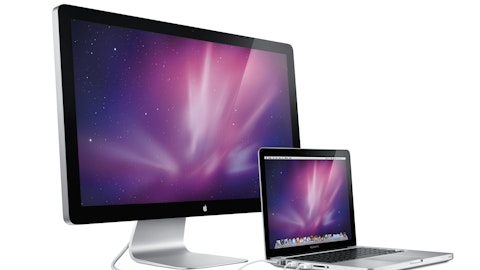Amazon.com, Inc. (NASDAQ:AMZN) is a company which seems to draw strong opinions from both sides. Some claim that Amazon is grossly overvalued with terrible margins and an inability to generate substantial profits. Others claim that Amazon is simply heavily investing in its future and that the company could make huge profits if it wanted to. They say revenue is the number to care about, not profits.

Free cash flow has looked a bit better. In the TTM period FCF was $1.06 billion, down from $2.09 billion in 2011. The average FCF in the 5-year period ending in 2011 was $2.01 billion, or 3.5% of the TTM revenue.
What has seen tremendous growth is Amazon’s revenue. Over the last decade revenue has grown at an annualized rate of 28.4%. The 5-year annualized growth rate is slightly lower at 26.5%. Both COGS and operating expenses as a percentage of revenue have risen at about the same rate.
The current stock price is $267.94 per share with a total diluted share count of 461 million, resulting in a market capitalization of $123.5 billion. Let’s calculate some TTM ratios:
| Price/Sales | 2.16 |
| Price/Gross Profit | 9.09 |
| Price/Operating Income | 232.6 |
| Price/Net Income | 3087.5 |
| Price/Operating Cash Flow | 36.7 |
| Price/Free Cash Flow | 116.6 |
| Price/Owner Earnings | 280.0 |
Data from Morningstar
These numbers look pretty terrible. An interesting point is that Amazon.com, Inc. (NASDAQ:AMZN) trades at 9x gross profit. For comparison, Apple Inc. (NASDAQ:AAPL), another company which has seen the same kind of incredible revenue growth, was trading at about 10x gross profit at the end fiscal 2012 (this was right around Apple’s all time high of $700 per share). The difference, of course, is that Apple was also trading at about 14-15 times FCF as opposed to Amazon’s 116. In other words, Apple generates incredible profits while Amazon does not. Why, then, does the market not care about Amazon’s profits? If Apple were valued at the same P/FCF ratio as Amazon it would have a market cap of $4.8 trillion! That’s trillion, with a ‘T’.
Let’s conduct a little experiment. Imagine that Amazon’s revenue continues to grow at 26.5% annually. Along with that, let’s say that free cash flow grows at the same rate, and I’ll use the 5-year average FCF of $2.01 billion as a starting point. Here’s the question: how long does it take for Amazon.com, Inc. (NASDAQ:AMZN) to generate enough FCF to be valued at 15x FCF based on today’s market price.
And that sums up the problem with Amazon. You’re paying tomorrow’s price today. All of the expected revenue growth in the world doesn’t mean anything if you’re overpaying by so much. People will claim that the Price/Sales ratio, which is 2.16, is reasonable for a retailer. Well, if that’s the case then Best Buy, which puts up similar FCF numbers to Amazon.com, Inc. (NASDAQ:AMZN), should be worth about 10 times its current market capitalization. Ultimately, sales mean absolutely nothing if they don’t generate profits. I couldn’t care less about sales. Profit is what matters.
The Bottom Line
People get emotional about Amazon. They start looking for any metric that justifies their position. In Amazon’s case, that metric is revenue. Amazon.com, Inc. (NASDAQ:AMZN) is a company which is very good at growing sales. But that’s not the kind of company I want to own. I want to own a company which is very good at growing profit. As a shareholder, you own the right to a share of the profits, not the sales. So do yourself a favor: don’t pay tomorrow’s price today.
The article Don’t Pay Tomorrow’s Price Today originally appeared on Fool.com.
Copyright © 1995 – 2013 The Motley Fool, LLC. All rights reserved. The Motley Fool has a disclosure policy.




